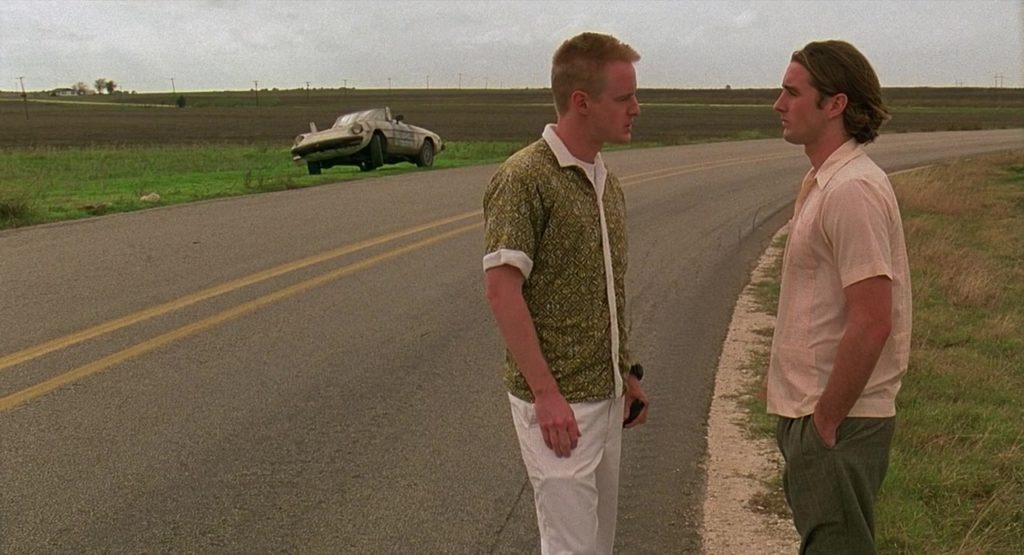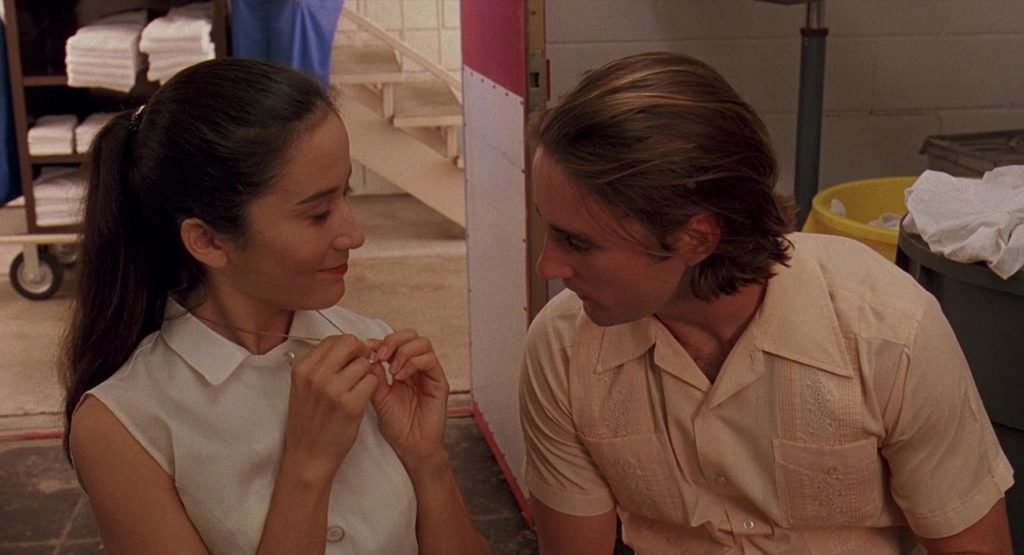A bigger bag, you idiot!
Bottle Rocket doesn’t display a fully-formed version of Wes Anderson’s signature style. But it’s closer than you might expect for a debut picture that premiered when Anderson was 27. In 1992, a year after graduating college, Anderson, his roommate Owen Wilson, and Wilson’s brother Luke made a short film that was selected for Sundance in 1994. Legendary comedy producer James L. Brooks saw it and decided to take a chance on the crew. Two years later, the feature film expanding the short premiered to good reviews, but tanked at the box office – it made a bit over $500,000 against a $5 million budget.
The film and Anderson’s eventual rise come from the ‘90s crop of indie directors: The success of Quentin Tarantino’s Reservoir Dogs and Robert Rodriguez’s El Mariachi in 1992 laid the groundwork for a new generation of self-made filmmakers getting chances with real studio money. Pulp Fiction two years later took the financial and critical success to a new level, and every studio was looking for the next wunderkind, especially at indie-accessible festivals like Sundance. This gold rush for young directors gave us a bunch of great (or at least cherished) filmmakers (e.g. PT Anderson, Alexander Payne, Kevin Smith, Darren Aronofsky, Sofia Coppola, etc.)

If Reservoir Dogs is the prototypical ‘90s indie film, Bottle Rocket is Wes Anderson’s reaction and interpretation of it, taking the bare bones of the former’s premise and filtering it through his own emerging style. The story also centers around a bungled heist, but told with thick layer of deadpan and irony, plus plenty of tenderness. The crooks are bored rich boys longing for something real in their life. It’s a comedy, not a drama or a thriller. And unlike Tarantino (and Danny Boyle and plenty of others from the era), the film has almost no violence, profanity, or nudity. No depravity for the sake of it.
But what Anderson has in common with Tarantino (and what plenty of his peers are missing) is his ability to get you to really care for the movie’s characters. On paper, these rich brats should be a miserable bunch to spend time with, but Anderson and co-writer/co-star Owen Wilson afford them all buckets of empathy without selling out their flaws and neuroses. Beyond all his visual inventiveness, that’s why Anderson has remained relevant: He tells stories with deeply thoughtful (often melancholic) cores despite their eccentric, meticulously-constructed exteriors.
Anderson’s visual identity is a work in progress here. He pairs with cinematographer Robert Yeoman for the first time, and the pair have collaborated on each of Anderson’s live action films since. It’s one of the most successful director-cinematographer pairings of the past generation, and we’re a couple of great films away from safely calling it one of the greatest pairings of all time.
The color palette of the film is not quite so exquisite and striking as Anderson and Yeoman would use in their later films, but there are still some terrific choices: Some yellow jumpsuits late in the film really pop, and the use of red is really striking (a sweater, a van, some blood). A few shots give us a preview of the coordinated color schemas that Anderson would be known for, like an all-pink composition of a girl flirting, or Owen Wilson’s Dignan lying in green grass with a green button-up.

Anderson also uses plenty of his trademark precise camera movements and flat, symmetrical compositions. His knack for a good quick-pan to deliver a punchline is sharp from the start. The precise rendering of nostalgic knick-knacks, another staple of Anderson’s technique, is used effectively here. Perhaps the most obviously Andersonian shots of the film are close-ups on the loot of a robbery, shot with the loving detail of collector.
The influences for Anderson’s filmmaking are diverse, but they definitely tilt European. There’s a lot of Godard in the look and sarcastic tone, though Anderson is not nearly as cynical as Godard. It’s obvious that Anderson loves the French New Wave in particular: the looseness of the story structure, youthful but tempered enthusiasm, and clever use of artifice are all key features here. It’s a totally different style from the grittier and more operatic genre pictures (mostly American) that Tarantino feasted on as a video store clerk.
In 2023, we tend to view Anderson as an insular filmmaker, but the early narrative on his career was that he was one member of a crew: He and the Wilsons – Owen, Luke, and older brother Andrew – worked as a team for a decade, from their college graduation through 2001’s The Royal Tenenbaums. Owen, his roommate and biggest co-conspirator, stuck around with Anderson even longer than that, and Bill Murray joined the club starting with Rushmore. (Murray was actually recruited for a part in Bottle Rocket ultimately given to James Caan, the film’s “washed up star” casting, another ’90s indie staple.) Thus, Bottle Rocket is a debut for Owen Wilson, too, and there was a period of a few years where Wilson was the biggest star of the group. (Wilson considered retiring from Hollywood after Bottle Rocket, but would be a household name just a few years later.)

Bottle Rocket’s story follows Anthony (L. Wilson) and Dignan (O. Wilson) as they plan a string of robberies, their journey briefly interrupted by a stay at a hotel where Anthony falls in love with a Spanish-speaking cleaning maid named Inez (Lumi Cavazos). This leads to a falling out between Dignan and Anthony, but they reunite just in time for one big job to go horribly wrong.
The narrative is honestly a little undercooked and episodic, which is the main reason that this is one of Anderson’s minor works. Anthony’s relationship with Inez is charming but not deep. The underlying joke that drives the whole movie – that Anthony and Dignan are rich kids of privilege essentially play-acting criminal to deal with their own boredom and sadness – doesn’t have quite the same emotional stakes or richness as Anderson’s best.
That said, the vibes and chemistry are outstanding. There’s a sense of collaboration and inventiveness here. This isn’t an idiosyncratic Anderson auteur project, but a shared vision in a way that would seem impossible twenty years later. Co-leads Owen Wilson and Luke Wilson each infuse the project with their own voice with distinct and memorable performances. I really enjoy the alternating exasperation and enthusiasm that Owen Wilson captures in reaction to to Luke Wilson’s easygoing charisma. The friendship between the pair is complicated but deep. It feels authentic, and quite honestly reminded me of friendships I’ve had.
Bottle Rocket is a funny movie, too, though most of the gags are dry rather than laugh-out-loud. It features lots of misunderstandings and slight twists on the expected cadence of scenes. My favorite bits come from the language barrier between Inez and Anthony: Anthony sees a picture in Inez’s locket, assumes it’s her as a baby, comments how adorable it is, and is unfazed when it turns out to be a picture of someone else. My biggest laugh from the film is a scene in which a boy named Rocky (Danny Caicedo) delivers a translation of Inez’s love without Dignan realizing it comes from Inez rather than Rocky himself.
Bottle Rocket ultimately works not just in spite of Anderson’s voice being a bit unformed, but because of its rough edges. His stew of deadpan comedy and sad but loving character portraits is a bit less filtered and manicured, making his oldest film feel honestly quite fresh. As Andesron’s career progressed and his films became more and more bespoke, the unkempt “group project” feeling of his debut stands out and remains immensely enjoyable.
Is It Good?
Very Good (6/8)
Dan is the founder and head critic of The Goods. Follow Dan on Letterboxd. Join the Discord for updates and discussion.

